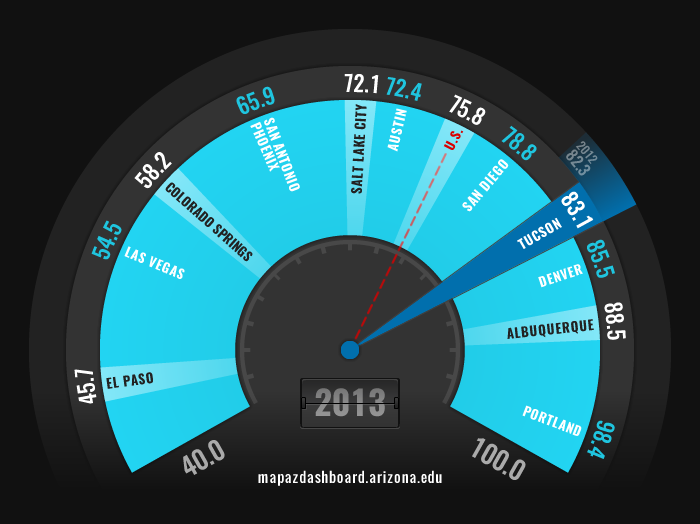How are we doing?
Primary Care Providers per 100,000 Residents (2013)

The Tucson Metropolitan Statistical Area (MSA) had 83.1 primary care providers per 100,000 residents in 2013. This ranked Tucson fourth out of 12 western MSAs, among which the Portland MSA ranked first at 98.4, and the El Paso MSA placed last with 45.7. Among 10 western states, Arizona ranked sixth, nine providers below the U.S. rate of 75.8. Oregon placed first with a rate of 93.2, and Nevada ranked 10th with 57.0. The rate of primary care providers has declined since 2009 in Tucson, the state of Arizona, and the U.S.
Why is it important?
The rate of primary care providers per 100,000 residents is an important measure of access to affordable medical and preventative care. A high rate may signify that residents are less likely to experience excessive wait times or travel to other regions for medical care –or be forced into more expensive alternatives such as urgent care or emergency room visits. The number of primary care physicians has decreased since 2000, as primary care pays less as a specialty than other medical disciplines. Recent efforts by the American Medical Association and various medical colleges have sought to remedy this shortage by streamlining and shortening primary care provider (M.D. /O.D.) curriculum.
How do we compare?
Among 10 western states, Arizona placed sixth with a rate of 66.4 providers per 100,000 residents in 2013. Oregon placed first with 93.2, and Nevada last with 57.0. Only Colorado, Washington, and Oregon had a rate over 80, with 81.2, 84.3, and 93.2 providers, respectively.
[[nid:1045]]
What are the key trends?
The rate of primary care providers per 100,000 residents has declined in the Tucson MSA, the state of Arizona, and the nation, since 2009. In Tucson, the rate has fallen by 10.5 providers between 2009 and 2013. The rate has fallen by a smaller number in Arizona (2.7) to 66.4, and a comparable amount nationally (15.7) to 75.8 during the same period.
[[nid:1061]]
How is it measured?
Primary care provider data are from County Health Rankings, a collaborative project between the Robert Wood Johnson Foundation and the School of Medicine and Public Health at the University of Wisconsin-Madison. Data are derived from over 50 sources and summarized in the Health Resources and Services Administration (HRSA) Area Resource File released annually in May by the U.S. Department of Health and Human Services. Individual sources of HRSA data include the American Medical Association, American Hospital Association, and the National Center for Health Statistics, U.S. Census Bureau, and the Bureau of Labor Statistics. The level of primary care providers is scaled to the total population levels by county to compute rates. Population data are from the Census 2013 Current Population Estimates.












